Japanese roads often have different rules between bicycles and cars, such as a bicycle being allowed to go against traffic on many one-way roads, or a bicycle being prohibited from certain road sections. However, the related traffic signage can be confusing even for Japanese natives.
Making it even more confusing is that certain kinds of situations have different signage in different parts of the country.
This article goes into some of the details as I understand them (which is imperfect, for sure).
First of all, under Japanese law, a bicycle is a vehicle, just as a car is a vehicle, so traffic signs and traffic laws fully apply to bicycles. For example, it's illegal for any vehicle, including bicycles, to travel on a sidewalk... unless, of course, there's signage or local ordinance explicitly allowing some kinds of vehicles, as is often the case for bicycles on sidewalks. Bicycles are vehicles under the law.
(This means, among much else, that bicycles must come to a complete and full stop at stop signs, may not cross red lights, must yield to pedestrians in marked crosswalks, and must stop at railroad tracks not controlled by a traffic light. I know cyclists who have been stopped by police for some of these infractions.)
Let's look at some of the basic road signs to recognize as a cyclist.
Signs that explicitly prohibit bicycles
 | Road Closed to all, even pedestrians. no bicycles |
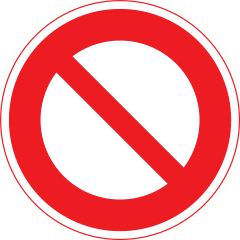 | No Vehicle Access to all vehicles. no bicycles |
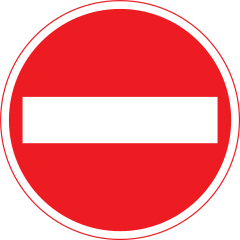 | No Entrance to all vehicles. no bicycles |
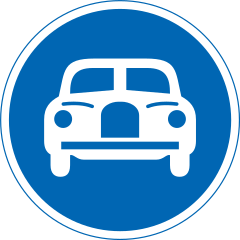 | Motor Vehicles Only (sort of) bicycles definitely not allowed |
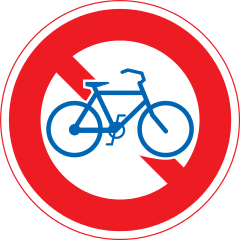 | No Bicycles that means you |
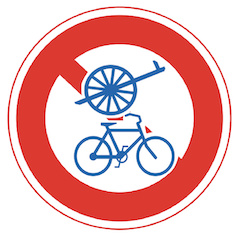 | No Non-Motorized Vehicles including bicycles |
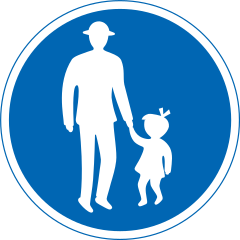 | Pedestrians Only
no bicycles |
Any of the signs above, unless augmented by additional clarifying signage, mean that you officially can't use the road while riding a bicycle (though in practice things may be different, so don't base your understanding of the law on what you observe others do).
For example, consider the two blue signs above: in practice if you ride in a “Pedestrians Only” zone, it's may be that no one will care, but if you ride on a “Motor Vehicles Only” road, you can expect to be stopped very quickly by someone acting in an official capacity.
On the other hand, these restrict others but not bicycles:
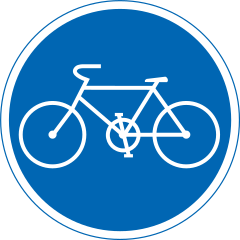 | Bicycles Only bicycles okay |
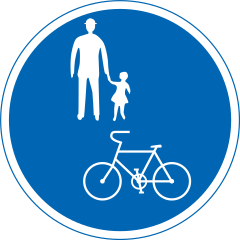 | Pedestrians and Bicycles Only bicycles okay Common for sidewalks |
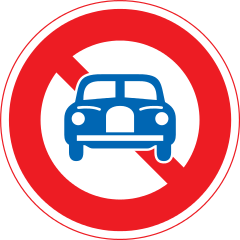 | No Motor Vehicles except two-wheel vehicles bicycles okay | 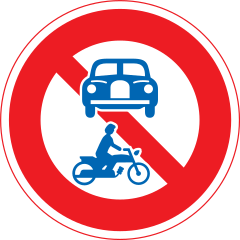 | No Motor Vehicles (sort of) bicycles okay |
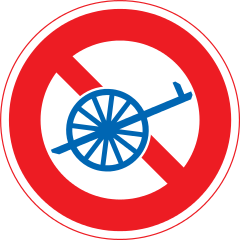 | No Non-Motorized Vehicles Except Bicycles bicycles okay |
Among the various uncommon signs that impact bicycles, I wanted to point this one out:
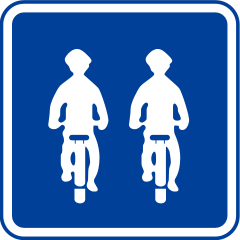 |
Riding side-by-side allowed |
Without the benefit of this sign, riding bicycles side by side is illegal. If you're in the middle of nowhere and you're not impacting cars, no one will care, but if you ride side-by-side on a busy street, holding up traffic behind you, you are wrong. Some cyclists I've met act as if they own the road and that the rules, whatever they are, don't apply to them. Don't be that jerk. If it doesn't bother anyone, sure, do whatever you like, but if you're going to break the law, at least don't be inconsiderate to others.
Anywway, all the signs above might seem confusing enough, but it gets worse. Much, much worse. Here's a common set of signs seen in my part of the country, where a one-way road empties into another:
Let's look at the signs in detail:
Generally speaking, traffic signs inform of a restriction of some sort — here we have “no entrance” and “one way” — but a restriction can be made more specific by additional little signs under it called 「補助標識」 (“subsignage”, hojo hyoushiki). In this case, both have the subsignage 「自転車を除く」 (“except bicycles”, jitennsha wo nozoku) under them, so these restrictions do not apply to bicycles. This road is not “one way” for bicycles, and they may travel either direction.
Some parts of Japan use different signage for essentially the same thing; we'll look at that later.
Here's a common sign that prohibits bicycles where most other vehicles may go:
This might at first seem as if it prohibits “bicycles and hand carts”, but on road signage, the hand-cart symbol officially signifies “non-motorized vehicles except bicycles”, so the above sign really means “no bicycles and no non-motorized vehicles except bicycles”.
In other words, it means what in English we would express by “motorized vehicles only”. So why isn't it expressed that way? Welcome to Japanese traffic law, which often comes across as if Yoda wrote it while trying to parody himself. Oh, are pedestrians allowed? Unlikely, because there's a wide sidewalk here. Mystifying. In any case, bicycles not allowed.
Here's the same sign (without the time limitation), and with an additional “no pedestrians” sign:
The same “no bicycles, no other non-motorized vehicles” sign makes an appearance here:
In the top center of the photo, one sign sort of sticking out to the right prohibits motorcycles from using the right lane, and though a bit blurry in this photo, our “no bicycles, no other non-motorized vehicles” sign is near it, also applying only to the right lane.
Oddly, pedestrians are restricted from the left lane but not the right, implying that pedestrians should use the right lane, which doesn't fit the vibe of this area which is that pedestrians shouldn't be here in the first place. I'm probably missing something important here.
An even bigger restriction — “motor vehicle only” — is used for highways and tollways:
In the photo above, the multiple sets of circle-with-a-slash restrictions (one each for “no scooters”, “no bicycles”, and “no pedestrians”) placed on the left side of the road are just an extra kindness likely placed at this specific location because they had a lot of trouble here; the heavy lifting is actually done by the small circular blue sign a bit farther in the distance:
(The small sign under the round blue one in this case is not one that makes the restriction more specific, but simply spells out that the road is a high-speed national motorway, and notes parenthetically that it's a toll road.)
I added “sort of” to the “Motor Vehicles Only” caption above because of quirks in how a Japanese legal term is translated to daily English. We'll see details later, but in this case I couldn't use this road with my 125cc scooter, even though in common English we'd consider it a motor vehicle.
Let's see another style of restriction:
The red circle on white with a slash means “closed to vehicles”, but there's a little clarifying sign under:
The small sign says 「原付・小特・軽車両」, limiting the “closed to vehicles” restriction to just the three classes of vehicle listed, which roughly speaking encompasses “scooters, small farm equipment, and non-motorized vehicles”. Bicycles are non-motorized vehicles, so bicycles may not enter this road.
This may seem complicated, but it's actually much more complicated than it looks.
Broadly speaking, Japanese law divides all vehicles into one of three main classes:
| Legal Class | Examples |
|---|---|
| 軽車両
keisharyo “Non-Motorized Vehicle” (literally “light vehicle”) |
Most human/animal-powered vehicles
bicycles, unicycles, ricksha, horse-drawn carts, kick-scooters, parade floats, sleds, tricycles, push-carts, dollies, etc. (Excluded: wheelchairs, walking aids, and toy vehicles for children are not legally “vehicles” at all) |
| 原動機付自転車
gendoukituki jitensha “Motor-Attached Bicycle” Common shorthand: 原付 (gentsuki) | Mopeds and scooters and motorcycles with a “small enough” engine displacement
those with an engine displacement of 50cc or less (some parts of the law)
|
| 自動車
jidousha “Motor Vehicle” (sort of) | Non-rail motorized vehicles not accounted for above
cars, trucks, cranes, buses, farm equipment, motorcycles with “big enough” engines, construction equipment, etc. (Trains and other rail vehicles are covered by totally different laws.) |
Each class has a myriad of subclasses, some of which you may encounter on signs. Let's revisit the “scooters, small farm equipment, and non-motorized vehicles” sign from above:
「原付・小特・軽車両」
- 原付 (gentsuki) — short for 「原動機付自転車」, the broad “motor-attached bicycle” class seen above.
- 小特 (shotoku) — short for 「小型特殊自動車」, “small special motorized vehicle”, a sub-class of the broad “motor vehicle” class seen above,
encompassing things like farm equipment and construction equipment that fall within certain maximum limits of size, power, and speed.
- 軽車両 (keisharyo) — the broad non-motorized “light vehicle” class seen above, which includes bicycles.
Sometimes it seems as if it requires a PhD in both language and logic to figure out some signs. Consider this example from my blog a decade ago:
Can you figure it out exactly what the restriction is? See the article for the convoluted answer.
Here's another example:
Again, see the blog post for an explanation.
The ones above are convoluted but with some effort those who read Japanese can figure them out. But sometimes it's just impossible to understand the meaning without knowing the specific rules of precedence and association that dictate what parts of the signs applies to what other parts:
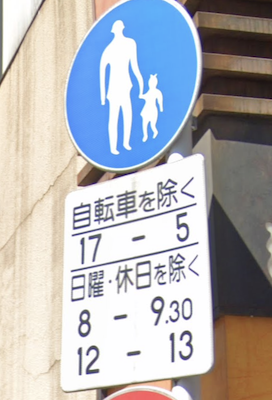 |
Pedestrians
except bicycles
5pm-5am except Sundays and holidays 8-9:30am Noon-1pm |
I brought this photo to a police station and had a fairly-senior-looking officer explain in detail what this meant. Later, I happened to come across a few traffic officers manning a speed trap and asked them, and got another detailed explanation... quite different from the first!
(All the officers I talked to said that the sign was horrible.)
|
Explanation 1
Pedestrians only, but bicycles allowed. This restriction against other vehicles applies only in the evening (5pm through to 5am), meaning that cars etc. can use the road during the day (5am through to 5pm). Also, the restriction doesn't apply during the two short periods on Sundays and holidays. |
Explanation 2
Pedestrians only, but bicycles allowed from 5pm through to 5am. Also, on weekdays, these restrictions also apply during two short additional periods. |
These are completely different (!!) and probably neither are correct. If those charged to enforce these kinds of signs have no idea what they really mean, how can average citizens?
Let's see whether we can figure it out.... (Hint: we can't)
The separator line above “except Sundays and holidays” seems to strongly indicate that the three lines below it (“except Sundays and holidays”, “8-9:30am”, and “Noon-1pm”) all go together, but the question is how do they combine and apply to the overall restriction? The double and triple negatives make my head spin. Is it that the restriction is in force only during the two time slots, but not at all on Sundays and holidays, or is it that on weekdays the restriction applies only during the two time slots? My current guess would be the latter, but ask me tomorrow and I might come to a different conclusion.
And then there's that separator between “except bicycles” and “5pm-5am”, making me feel that those lines don't go together and that each applies to the overall restriction independently. That's what we see in Explanation 1. But if so, why would they use “pedestrians only” with an “except bicycles” modifier when there's a perfectly good “pedestrians and bicycles only” sign? Maybe that's just the way they do things: I came across a standalone “pedestrians only” with an “except bicycles” modifier just today. It makes no sense to me.
All that being said, how does the “5pm-5am” line combine with the bottom half of the sign? Does the bottom half add to the “5pm-5am” on some days, or replace it on those days?
The relevant Japanese law (around 第2章 第3-8(6)ア in this PDF) says that separator lines may be used for clarification, but it doesn't seem to help in this case.
Sigh, I have no idea.
For reference, here's a case where no black-separator line is used, but it's clear:
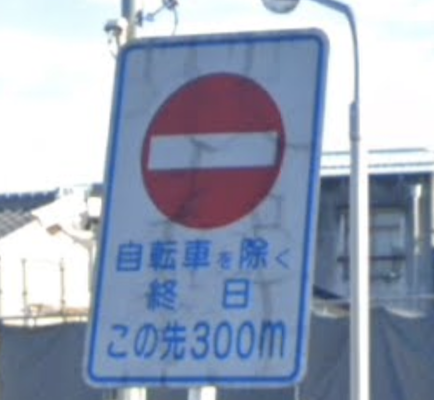 |
NO ENTRANCE
except bicycles
all day 300m ahead |
Here's another example not uncommon in my area:
This is a standard “No Entrance” sign, with the little sign under limiting the restriction to 「自動車」(most motor-vehicles except some scooters), but then the parenthetical 「二輪を除く」removes all motorcycles from the restriction. So, all motorized two-wheeled vehicles and all non-powered vehicles (which includes bicycles) can go both ways.
Some Extra Notes
Vehicles that would seem to belong to one category can actually be placed in another, depending on a variety of special conditions. For example, a “pedal-assist” bicycle, which has a motor to assist the user while pedaling, but won't propel the vehicle otherwise, can legally be a “bicycle” if the motor is weak enough.
In the law (and on traffic signs),「自転車」(“bicycle”) has a specific legal meaning that includes specifications on size and on the number and type of people it's designed to accommodate. Generally, it's what one would consider a “normal” bicycle. But note that a tandem bicycle — a bicycle designed for two or more operators — is not legally a “bicycle”, so it falls into the general non-motorized “light vehicle” category. We'll see later an example of where this can be an important distinction.
However, each prefecture has its own laws about tandem bicycles, mentioned in short in this Wikipedia page. Tandem bicycles had been generally prohibited on roads until recently, but as of this writing most such restrictions have been removed.
Electric vehicles of all sorts, other than the pedal-assist bicycle just mentioned (and mobility-assist devices, etc. that are not legally a vehicle), generally fall into one of the motorized-vehicle categories, all of which requires a valid driver's license to operate, and proper vehicular licensing to use on public roads. This (currently) includes even weakly-powered vehicles like electric skateboards, hoverboards, and electric kick scooters, though as of this writing the law is slated to change to allow unlicensed use of these kinds of things. We'll see.
The moment you dismount your bicycle and push it while walking, you are now a pedestrian and the bike is just something you have with you. This is a special rule that does not apply to most other non-motorized vehicles, such as push carts and rickshaw and parade floats, which are initially designed to be pushed or pulled, and so are “vehicles” under all conditions.
Three-wheeled vehicles are placed into categories depending on a variety of factors, including size, whether they have an engine (and how powerful the engine is, and how it is interacted with), maximum powered speed, etc. Depending on these, they can be placed into any of the broad vehicle categories.
Trivia: ask the average Japanese person what 「軽車両」(keisharyo) refers to, and instead of the correct answer (“the broad class encompassing non-motorized vehicles, including bicycles”), you'll likely hear the definition for 「軽自動車」(keijidousha), which is a sub-class of automobile meeting certain size and engine restrictions that enjoys beneficial taxation and parking, and can be identified by the fact that their license plates use a black/yellow color scheme, instead of the normal white/green.
In some prefectures, bicycles are allowed in both directions on most one-way streets in this way:
Here, the modifier signs say 「自動車・原付」, which as we saw above are the two motorized broad category of vehicles, meaning that the restrictions do not apply to the third, the non-motorized “light vehicle” category, which of course includes bicycles. So, bicycles can ride either direction.
As you'll recall, in my area the restrictions exempt only bicycles, but here all non-motorized vehicles are exempted. The difference between the two are all the other (non-bicycle) non-motorized vehicles, such as tandem bicycles, tricycles, unicycles, etc. In my area, they are limited by the one-way sign, but in the area of the photo above, they can travel both ways. What a weird local difference.
One last thing to note is the difference between these similar signs:
 | Road Closed to all, even pedestrians |
 | No Vehicle Access to all vehicles (including bicycles) |
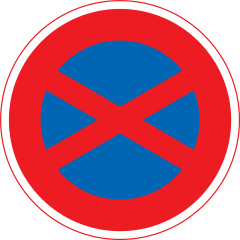 | No Stopping | 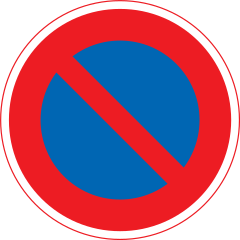 | No Parking |
If you made it this far, congratulations; you're ready to ride.
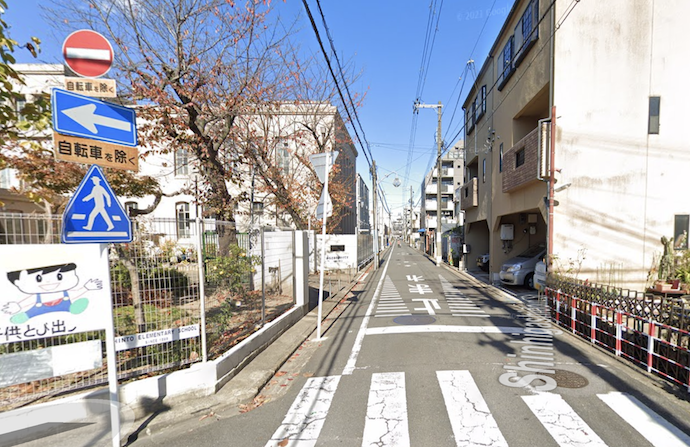
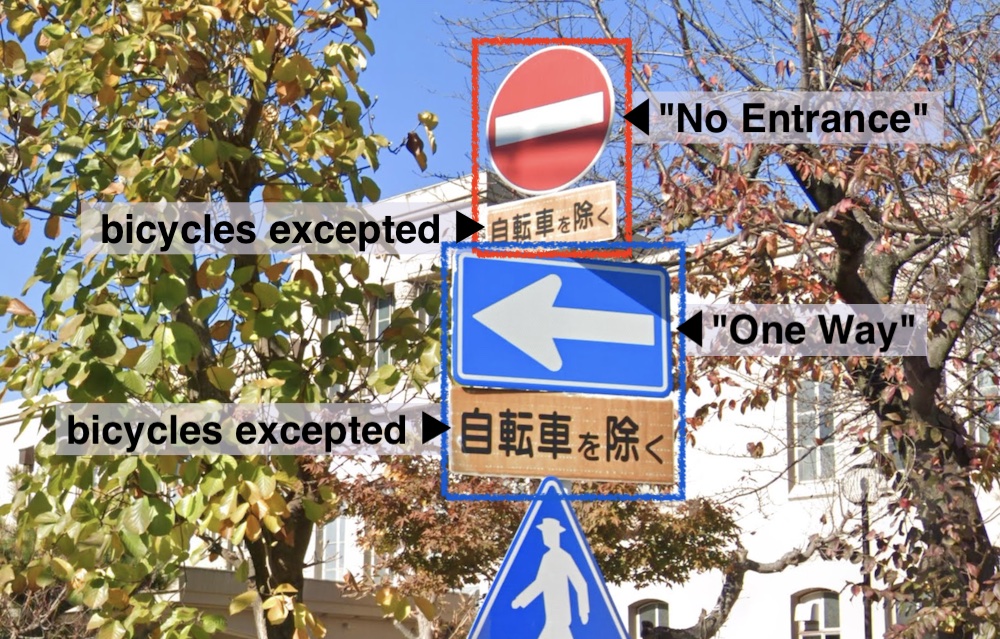
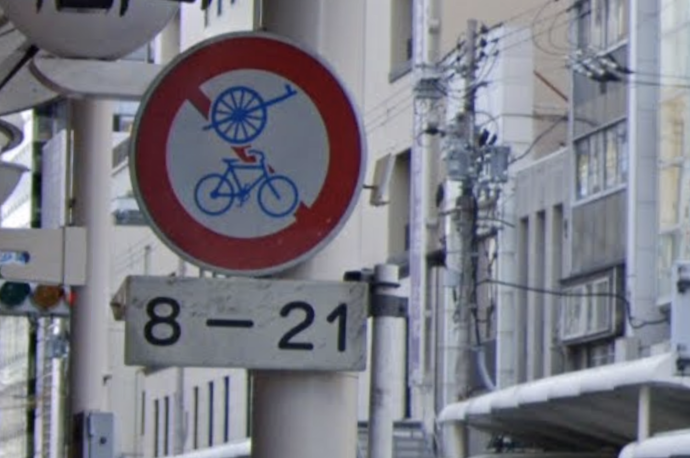
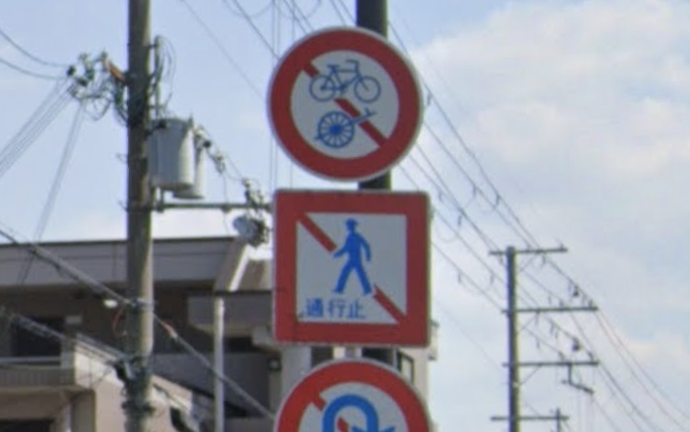
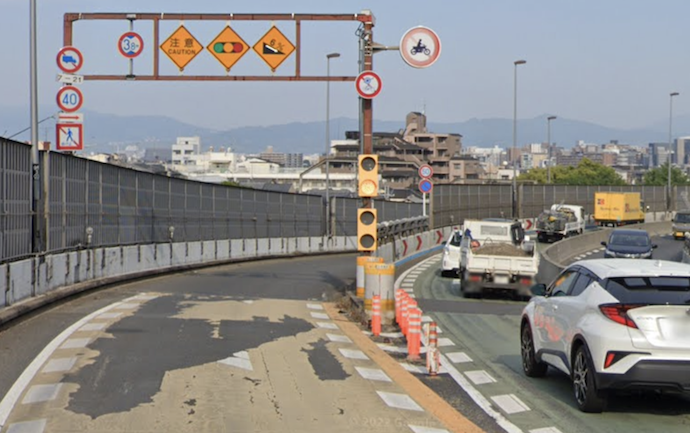
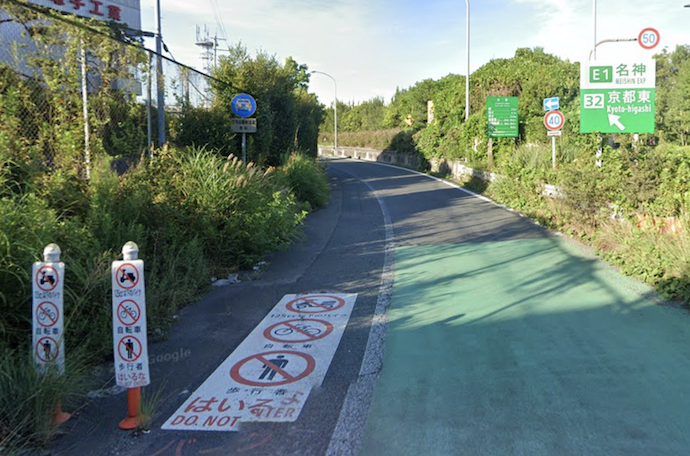
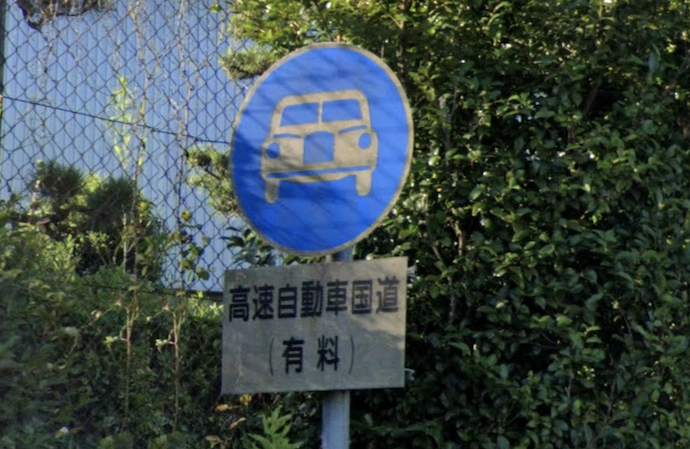
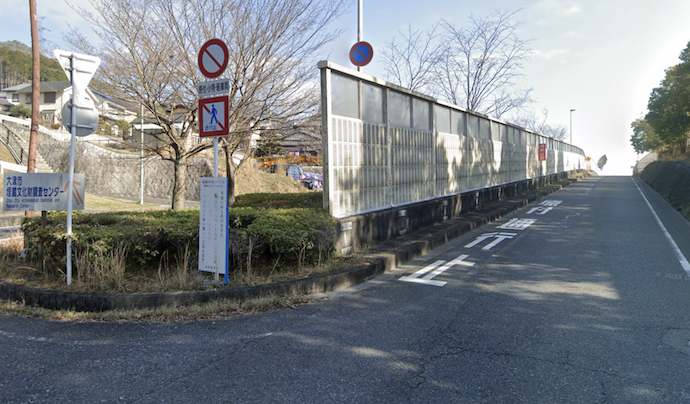

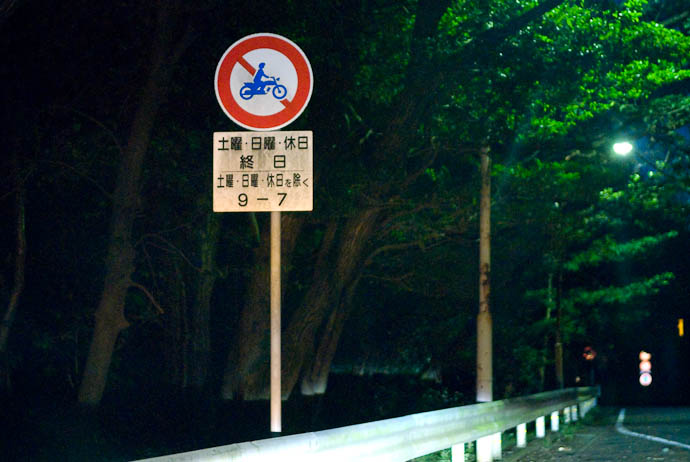
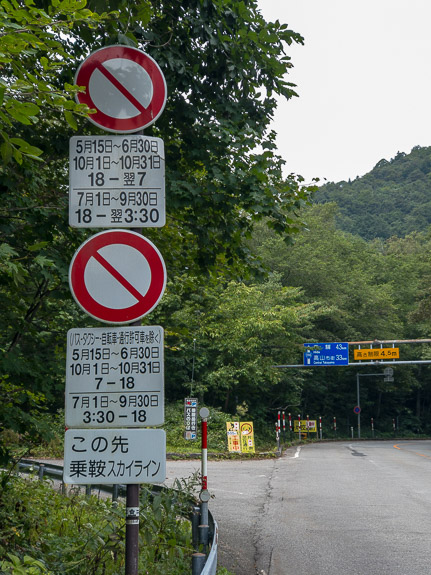
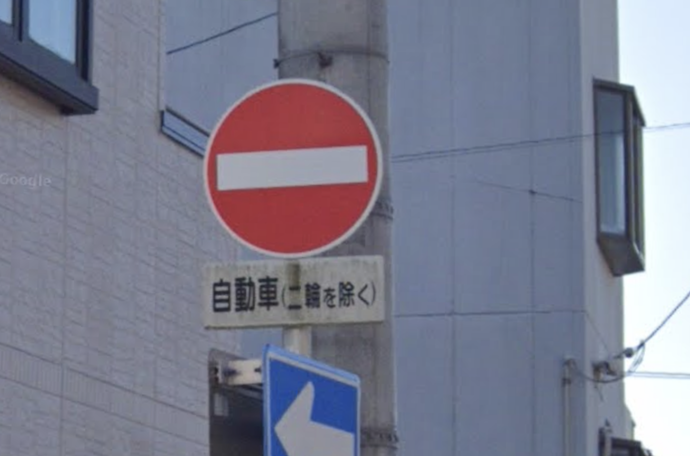
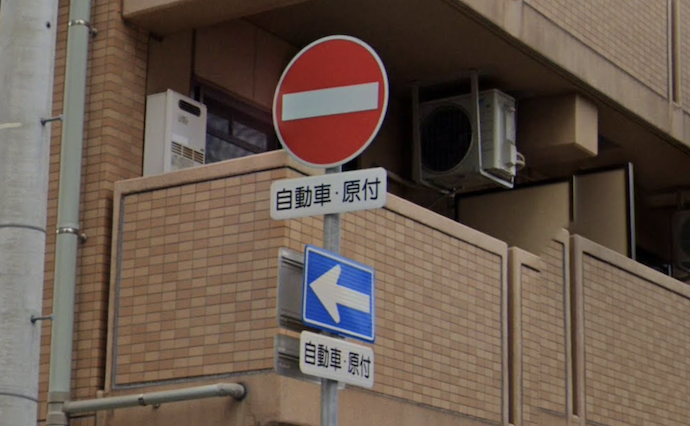
That’s a fun post! And yes, I did manage to drag myself through all of it. Now I have some knowledge that I’m not sure I’ll use anytime soon, but was still quite interesting.
thanks for all the wonderful details & (sort of) clarifications….most of it made my brain hurt……(@.@)/